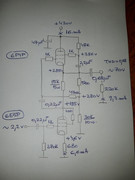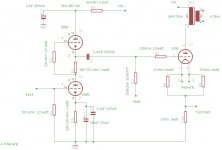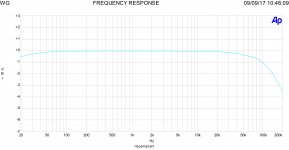With 450 volt and 90 mA you are little bit more than 40 watt that is the max anode dissipation ( for a original 300B ).
If you read the data sheet from W. E. there is a very fine table with lot of power stage configuration as V bias, current and load.
Walter
36W max. plate dissipation says the original WE datasheet.
The supply voltage is 450v and the voltage drop in the primary transformer is 19v but they can reduce the anodic current to the 80-85 mA to the detriment of the slight incresase of THD withhout the harmonic spectrum changing. I tested two more transformers of 3,5K and 4,2K but i prefer to stick to the 5.2K
19V drop and 80mA current on 237 Ohm DCR?
A little bit DCR of transformer. It limits the power, and if you raise the anode voltage the distortion would be grooving rapidly.
The overall THD is depends on driver stage too.
Near to maximum swing of 300B grid the weak driver stage begins to distort.
A little bit DCR of transformer. It limits the power, and if you raise the anode voltage the distortion would be grooving rapidly.
The overall THD is depends on driver stage too.
Near to maximum swing of 300B grid the weak driver stage begins to distort.
Bernie88,
Look at this 1938 Western Electric 300A / 300B data sheet.
40 Watts plate dissipation.
http://www.tubebooks.org/tubedata/we300a_b.pdf
That is the Earliest WE 300A/300B data sheet that I can find.
And, the original WE 300A data sheet from 1936 at Franks tubes:
40 Watts plate dissipation.
Then go to Franks tubes, and look at the Western Electric 1950 300B data sheet.
36 Watts plate dissipation.
As I said, all things are subject to change.
Your Mileage May Vary.
Look at this 1938 Western Electric 300A / 300B data sheet.
40 Watts plate dissipation.
http://www.tubebooks.org/tubedata/we300a_b.pdf
That is the Earliest WE 300A/300B data sheet that I can find.
And, the original WE 300A data sheet from 1936 at Franks tubes:
40 Watts plate dissipation.
Then go to Franks tubes, and look at the Western Electric 1950 300B data sheet.
36 Watts plate dissipation.
As I said, all things are subject to change.
Your Mileage May Vary.
Thanks for sharing. In respect of the mileage to go with this tube, my rating would always be on the conservative side.
WE 300B is sports of the kings. The last engraved 300B tube on ebay went for more than $4K. Not many kings here, so they have to use replica tubes. Their data and sound can vary a lot so its always good to look at the real tubes datasheet.
WE 300B is sports of the kings. The last engraved 300B tube on ebay went for more than $4K. Not many kings here, so they have to use replica tubes. Their data and sound can vary a lot so its always good to look at the real tubes datasheet.
Last edited:
Because for more than one reason.
Their tubes are out of budget at the moment, I never use and buy replica tubes and always have used original tubes from the golden era of tube audio. There are so many available that the need to use modern replica tubes with me is zero.
I appreciate the work of those companies, but will never become a customer.
They can be of good, excellent or bad quality, but I'm not the person going to find that out. Others can make their own experiences and pay money for it.
Electron tubes are just consumables in an amp.
If I had an extra budget of $20K I would have bought a stash of original 300B to be used with the given amp for a lifetime.
Otherwise, I use different tubes which do better match the budget.
There are plenty of them available.
Last edited:
If I had an extra budget of $20K I would have bought a stash of original 300B to be used with the given amp for a lifetime. Otherwise, I use different tubes which do better match the budget. There are plenty of them available.
I've switched from 300b to 6B4G/6C4C. Much lighter on the pocket and in fact I prefer them to the 300b EH I was using. That's a win-win.
There are so many excellent sleepers out there to be heard in a good application before I would go for a big budget 300B amp.I've switched from 300b to 6B4G/6C4C. Much lighter on the pocket and in fact I prefer them to the 300b EH I was using. That's a win-win.
I have to admit that an excellent NOS triode like an EB III (Telefunken) plays music extremely well. But looking ahead and seeing the trouble to fetch the last NOS examples from the market and having auditioned my pentode amp for five minutes, I'm so involved into the music I've forgotten the sound of the triode, instead loving the extra punch of the pentode. There should be an amp for every music style, but isn't that a bid snobistic anyway.
In the end, concepts are more worth in terms of sound than a single tube in an amp.
Last edited:
@Bernie88, those statements are quite true.
I would also say that, in my current quest of putting together design that I would eventually want tu build, I'm much more interested in Single-Ended/Triode as a concept than in the 300b in particular. It's just that the 300b is such an ubiquitus contender in that arena and has so much "hype" going on about it that I get very much drawn to it in terms of "well, if I'm going to build a SE/Triode Amp, I might as well go for 300b"
That being said, looking at various biasing schemes, I have a question for you guys that is probably painfully basic...
I find the idea of DC coupling very interesting. In the examples I've seen so far, that leads to either having to use a quite high B+ volatge (+700V in the Komuro 300B DC coupled design) or it constrains the design of the driver stage to not have a too high of a plate voltage so that the potentials in the output stage can be kept at a more moderate level...
Does DC coupling work with a fixed bias approach? If the driver stage has a plate voltage of e.g. 250V and we use a volatge source of -315V in order to end up with -65V bias on the 300b's grid - will that work?
I would also say that, in my current quest of putting together design that I would eventually want tu build, I'm much more interested in Single-Ended/Triode as a concept than in the 300b in particular. It's just that the 300b is such an ubiquitus contender in that arena and has so much "hype" going on about it that I get very much drawn to it in terms of "well, if I'm going to build a SE/Triode Amp, I might as well go for 300b"
That being said, looking at various biasing schemes, I have a question for you guys that is probably painfully basic...
I find the idea of DC coupling very interesting. In the examples I've seen so far, that leads to either having to use a quite high B+ volatge (+700V in the Komuro 300B DC coupled design) or it constrains the design of the driver stage to not have a too high of a plate voltage so that the potentials in the output stage can be kept at a more moderate level...
Does DC coupling work with a fixed bias approach? If the driver stage has a plate voltage of e.g. 250V and we use a volatge source of -315V in order to end up with -65V bias on the 300b's grid - will that work?
If you like the hazard you can use the DC.
And there isn't one reason to use it.
I will propose you another circuit.
In attach the circuit. the E88C, single triode in SRPP.
Good gain and realtive low Zout
The frequency response of the input stage.
Input 450 mV, out 20 Volt with Ia of 10 mA
Gain 42 times, Zout=1k2 ohm
Walter
And there isn't one reason to use it.
I will propose you another circuit.
In attach the circuit. the E88C, single triode in SRPP.
Good gain and realtive low Zout
The frequency response of the input stage.
Input 450 mV, out 20 Volt with Ia of 10 mA
Gain 42 times, Zout=1k2 ohm
Walter
Attachments
The concept of DC coupling not only is restricted where the extra mains voltage is available, it just leads towards the straight wire philosophy. Most often, people think to ged rid of components makes for a cleaner sound. And that leads ultimately to the straight wire amplifier. An amp, that simply should sound like this piece of wire and has no sound at all.
But this is unrealistic, because even the AC mains transformer has a unique sound characteristic that defines the amps character. Every other piece of that amp has its own sound, too. So to have, in the end, an amp witout its own sound character means to cook a meal without any taste and nobody wants this.
What we want in amps are defined qualities, and we have to accept to live with the sound of an amp and its parts. We cannot minimise this and even if we could, it would, technically, be the wrong way to construct such an amp. Because a good amp plays with the incoming signal and transforms it in the right manner. Many transforms the signal in the wrong manner, and thats because the cook isn't good and he doesn't use best ingredients. Most often both of it could be applied.
What sounds excellent is a 300B amp, driven by an excellent interstage. But this cost substantially money. And the better the transformer, the more money it costs. So not many people are doing it that way. Second best, to me, is being driven with a CCS loaded driver.
Much more on the cheap side.
But this is unrealistic, because even the AC mains transformer has a unique sound characteristic that defines the amps character. Every other piece of that amp has its own sound, too. So to have, in the end, an amp witout its own sound character means to cook a meal without any taste and nobody wants this.
What we want in amps are defined qualities, and we have to accept to live with the sound of an amp and its parts. We cannot minimise this and even if we could, it would, technically, be the wrong way to construct such an amp. Because a good amp plays with the incoming signal and transforms it in the right manner. Many transforms the signal in the wrong manner, and thats because the cook isn't good and he doesn't use best ingredients. Most often both of it could be applied.
What sounds excellent is a 300B amp, driven by an excellent interstage. But this cost substantially money. And the better the transformer, the more money it costs. So not many people are doing it that way. Second best, to me, is being driven with a CCS loaded driver.
Much more on the cheap side.
So to have, in the end, an amp witout its own sound character means to cook a meal without any taste and nobody wants this.
What we want in amps are defined qualities, and we have to accept to live with the sound of an amp and its parts. We cannot minimise this and even if we could, it would, technically, be the wrong way to construct such an amp. Because a good amp plays with the incoming signal and transforms it in the right manner...
I love this analogy. For a given dish, there there may be various opinions on whether a given ingredient should be used or not. There may also be a range on options given the quality and price of a given ingridient...
Speaking of ingridients - What do you think of using a pentode in the driver stage for a 300B? It may be a matter of taste but some have argued that an all-triode design might sound too "sirupy"...
I love this analogy. For a given dish, there there may be various opinions on whether a given ingredient should be used or not. There may also be a range on options given the quality and price of a given ingridient...
That is what is so great about DIY, you can tailor it to what you like!
I used a lot of triode drivers and ended with a C3o pentode. I will never go back to triodeI love this analogy. For a given dish, there there may be various opinions on whether a given ingredient should be used or not. There may also be a range on options given the quality and price of a given ingridient...
Speaking of ingridients - What do you think of using a pentode in the driver stage for a 300B? It may be a matter of taste but some have argued that an all-triode design might sound too "sirupy"...
- Home
- Amplifiers
- Tubes / Valves
- Looking for a 300b SE design


